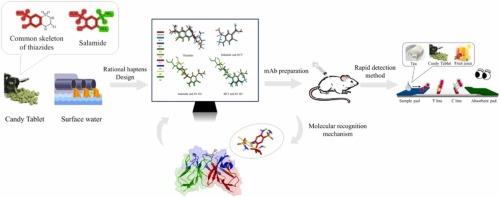Broad-spectrum antibody against thiazides and degraded salamide and immunoassay establishment for simultaneous detection
IF 12.2
1区 环境科学与生态学
Q1 ENGINEERING, ENVIRONMENTAL
引用次数: 0
Abstract
The illegal additive thiazides and degraded salamide in food supplements poses significant health risks and regulatory challenges. However, the structural differences between thiazides and salamide complicate the hapten design for immunoassay detection. In this study, we first outlined the common skeleton of thiazides and their shared epitopes with salamide through molecular overlap and atomic charge distribution analysis. Several haptens were rationally designed based on the private epitope of salamide and the shared epitopes with thiazides, assisted by computer-aided chemical analysis. Subsequently, the resultant monoclonal antibody exhibited broad specificity for thiazides (IC50 value = 21.43 to 358.76 ng/mL) and salamide (IC50 value = 0.76 ng/mL). The immunoassay affinities of 5 of these thiazides are reported for the first time. Further elucidation of the intrinsic recognition mechanism was achieved through homology modeling and molecular docking, clarifying the antibody's diverse recognition spectrum. Finally, we established a rapid, reliable colloidal gold-based immunochromatography strip for simultaneous detecting total thiazides and degraded salamide in food supplements and surface water sample for the first time. The cut-off value was as low as 7.5 ng/mL, which was 32 times more sensitive than that of established immunoassays for thiazides.

求助全文
约1分钟内获得全文
求助全文
来源期刊

Journal of Hazardous Materials
工程技术-工程:环境
CiteScore
25.40
自引率
5.90%
发文量
3059
审稿时长
58 days
期刊介绍:
The Journal of Hazardous Materials serves as a global platform for promoting cutting-edge research in the field of Environmental Science and Engineering. Our publication features a wide range of articles, including full-length research papers, review articles, and perspectives, with the aim of enhancing our understanding of the dangers and risks associated with various materials concerning public health and the environment. It is important to note that the term "environmental contaminants" refers specifically to substances that pose hazardous effects through contamination, while excluding those that do not have such impacts on the environment or human health. Moreover, we emphasize the distinction between wastes and hazardous materials in order to provide further clarity on the scope of the journal. We have a keen interest in exploring specific compounds and microbial agents that have adverse effects on the environment.
 求助内容:
求助内容: 应助结果提醒方式:
应助结果提醒方式:


